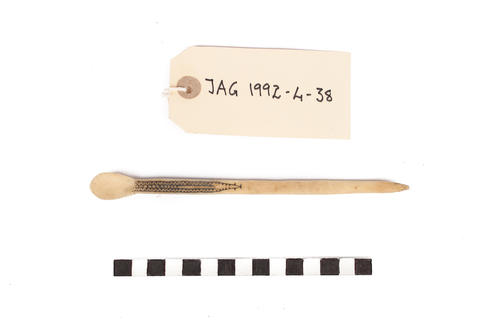Zone du titre et de la mention de responsabilité
Titre propre
Snuff spoon
Dénomination générale des documents
- Objet
Titre parallèle
Compléments du titre
Mentions de responsabilité du titre
Notes du titre
- Source du titre propre: FHYA using JAG materials
Niveau de description
Pièce
Cote
Zone de l'édition
Mention d'édition
Mentions de responsabilité relatives à l'édition
Zone des précisions relatives à la catégorie de documents
Mention d'échelle (cartographique)
Mention de projection (cartographique)
Mention des coordonnées (cartographiques)
Mention d'échelle (architecturale)
Juridiction responsable et dénomination (philatélique)
Zone des dates de production
Date(s)
-
2017 - (Online curation)
-
YYYY (Making)
Zone de description matérielle
Description matérielle
Zone de la collection
Titre propre de la collection
Titres parallèles de la collection
Compléments du titre de la collection
Mention de responsabilité relative à la collection
Numérotation à l'intérieur de la collection
Note sur la collection
Zone de la description archivistique
Historique de la conservation
Portée et contenu
Zone des notes
État de conservation
Source immédiate d'acquisition
Classement
Langue des documents
Écriture des documents
Localisation des originaux
Disponibilité d'autres formats
Restrictions d'accès
Délais d'utilisation, de reproduction et de publication
Creative Commons License: CC BY-NC-ND
https://creativecommons.org/licenses/by-nc-nd/3.0/
Unless otherwise stated the copyright of all material on the FHYA resides with the contributing institution/custodian.
Instruments de recherche
Éléments associés
Accroissements
Note générale
Description
[Source - Nessa Leibhammer for FHYA using JAG materials, 2017: Snuff spoon, Pondo; Material: Bone, pigment.]
Note générale
Acquisition
[Source - Nessa Leibhammer for FHYA, 2017: JAG accessioned the item as Pondo (see also Mpondo as part of Cape Nguni as per Van Warmelo’ s classifications). In the 1840s 50s and 60s, after British annexation of the area known as the Colony of Natal, some colonial writers referred to the inhabitants as Zulus because of their linguistic similarities to those who lived north of the Thukela in the Zulu Kingdom. This term obscured many fissures and differences of identity that existed at the time. Towards the end of the 19th century the notion of sameness strengthened in local African communities in opposition to colonial oppression (Wright in Tribing and Untribing the Archive 2016, pp. 202, 212, 213, 214).]
Note générale
Attributions and conjectures
[Source - Nessa Leibhammer for FHYA, 2017: Comments on classification: In his ‘A Preliminary Survey of the Bantu Tribes of South Africa’, Union of South Africa, Department of Native Affairs, Ethnological Publications, Vol. 5, Pretoria, Government Printer, (1935): 7, 70-83, national government ethnologist, Nicholas Van Warmelo did not use the term “North Nguni”. He grouped people living both north and south of the Thukela, under one umbrella term, “Natal Nguni”, based on linguistic affinity. His classification was adapted by the ethnology curator, Margaret Shaw, in her 1958 “System of Cataloguing Ethnographic Material in Museums” which determined that items from the region were to be classified as “Natal Nguni: Zulu and others (not differentiated).” According to art historian, Anitra Nettleton, the classificatory system used by art galleries and museum shifted from Shaw’s model to the one where “Natal Nguni” fell away and was replaced by “North/Northern Nguni” for KwaZulu-Natal and Swaziland because scholars found it difficult to distinguish items from adjacent areas, or emmigrant people from those from the KZN region. Scholars working with the JAG materials used broad ethno-linguistic categories (Zulu, Xhosa, Tsonga, Shona, Sotho, Tswana) to identify the makers/users of the objects, all of which came to JAG without much by way of provenance, and identification was based on factors such as object type, materials, formal composition, style and surface patterning (emails A. Nettleton to N. Leibhammer, 25 and 28 November 2014).]
Identifiant(s) alternatif(s)
Zone du numéro normalisé
Numéro normalisé
Mots-clés
Mots-clés - Sujets
Mots-clés - Lieux
Mots-clés - Noms
- Five Hundred Year Archive (FHYA) ()
- Johannesburg Art Gallery (JAG) (Conservation)
- Ken Karner (Collection)
- No attribution ()




Material contributed by members of the public
Building an archive is a collective endeavour. Please help us grow the FHYA knowledge base.
If you want to add information to this page you can insert a hyperlink, add files and/or text to the box below.
In the case of material relevant to the FHYA as a whole please upload information HERE.
The FHYA does not vet this material but reserves the right to remove anything deemed to be racist, homophobic, sexist or otherwise offensive. Everything on the FHYA is licensed under a Creative Commons CC BY-NC-ND licence.
To make a contribution you must be a registered user. To register an account, click here. Note that after registration you will not be automatically redirected to this page.
If you have already registered but are not logged in, log in here.